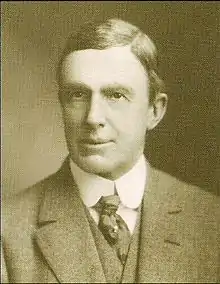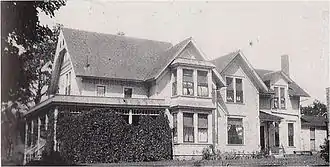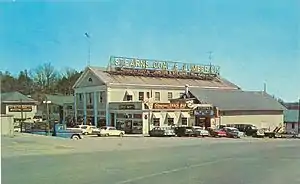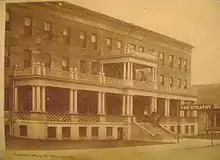Justus Smith Stearns
Justus Smith Stearns (April 10, 1845 – February 14, 1933) was an American lumber baron and businessman. He was involved in many other enterprises that involved commercial real estate development, sawmills, coal, farming, and technology. He started his lumber pursuits as a teenager at his father's sawmills. From the business knowledge he learned from his father he became a lumber merchant in his twenties.
Justus Smith Stearns | |
|---|---|
 ca. 1885 | |
| Born | April 10, 1845 |
| Died | February 14, 1933 (aged 87) |
| Resting place | Ludington, Michigan |
| Nationality | American |
| Other names | Justus S. Stearns J.S. Stearns |
| Education | elementary |
| Occupation | businessman |
| Known for | developing western Michigan and southeastern Kentucky |
| Title | President of many companies |
| Political party | Republican |
| Spouse(s) | Paulina Lyon |
| Children | Robert Lyon Stearns born March 14, 1872 |
| Parent(s) | Heman S. Stearns Mabel (Smith) Stearns |
Stearns, as a lumber dealer, was associated with his wealthy brother-in-law Eber Brock Ward as a vendor for quantities of lumber to lumberyard suppliers. Later in his thirties he moved to Michigan to manage Ward's lumber operations he had going there that at that time was inherited by Ward's widow. He worked his way up in management responsibilities and eventually became general managing agent for Ward's extensive lumber empire. He then developed his own lumber operations in northern Michigan and became a lumber baron.
Stearns had large timber interests in the Pacific Northwest, Michigan, Wisconsin, Kentucky, and Florida and became known as the Pine King. He was involved in commercial development, banking, mining, electrical, and railroading. He was the major influence in the development of the towns of Ludington, Michigan, and Stearns, Kentucky.
Early life
Stearns' father was Herman Swift Stearns (born 1819 in Vermont) and his mother Mabel E. Smith (born 1823 in Connecticut), the daughter of a merchant shipman. They were married April 19, 1842. Stearns was born in the Van Buren Harbor area of the village of Fredonia in the town of Pomfret, New York, April 10, 1845. He was an only child in a middle upper-class household. His mother had one sibling named Justus, who died in 1841 of a boating accident at around the age of twenty. Stearns received his name from his uncle who had this tragic death at such an early age.[1]
Stearns had limited formal education, with common schooling at the district public school of Chautauqua County, New York.[2] He was trained as a farmer's chore boy as was usual at the time in the state of New York. One of his duties was to milk twelve cows each day before he could go to school, a three-mile morning walk.[1] His formal education was concluded while an early teen with a business course at a college in Poughkeepsie, New York.[3] His practical business education was learned at his father's Pomfret sawmill where he worked as a teenager each Saturday. There he was a laborer and clerk in the retail lumber business processing loads of lumber for customers.[1]
Stearns' family moved from the Pomfret area to Erie, Pennsylvania, in 1861 when he was sixteen years old.[4] He worked with his father in the lumber business in Erie as an assistant manager until 1864 when the family then moved to Conneaut, Ohio.[4] There Stearns came to know his future wife, Miss Paulina Lyon, four years his junior.[5] They were married at the home of Pauline's mother on March 4, 1868.[5] There they lived with the well-to-do Lyon family for the first few years of their marriage.[5] They had one child, Robert Lyon Stearns, born March 14, 1872.[5]
Stearns had continued in the lumber business as a merchant in Conneaut after he was married. He also made hardwood lumber on a contract basis at a mill 12 miles outside Toledo near the Great Black Swamp area in northwestern Ohio. Business financial set-backs occurred for him when his wealthy brother-in-law Eber Brock Ward of Michigan died unexpectedly in 1875. Stearns had contracted with lumberman Ward as a vendor for large supplies of lumber that he had under sales contracts to furnish to suppliers in Ohio. When Ward died that stopped the flow of these lumber supplies since Ward's estate was tied up in litigation for three years.[3] At the time the nation was still in an economic slow-down due to the financial panic of 1873. Stearns' mother, at the age of fifty-three, also died in 1875. All these problems caused Stearns to go into bankruptcy.[6]
Stearns, at the age of 31, decided in 1876 to go to Ludington, Michigan, to help his widowed sister-in-law Catherine. She was the sister to his wife and the widowed wife of Ward. His duties in Ludington consisted of the further development of the existing Ward operations in Mason County, Michigan. Initially he was a clerk working for his brother-in-law, Thomas R. Lyon. Lyon was the general managing agent of Ward's extensive lumber empire. Stearns proved his management skills were outstanding and was promoted to cashier at the main office in 1878. He became successful and by 1879 was a key member in the lumber industry of northern Michigan.[3]

Stearns in 1880 made his own lumbering operations of Stearns Siding, a sawmill settlement some 30 miles (48 km) east of Ludington, in adjacent Lake County. The Mason County Record newspaper of Ludington reported in the spring of the construction development. When the sawmill initially opened it had 30 men that were capable of manufacturing 35,000 board feet of lumber per day ready to be shipped.[7] The first sawmill was located two miles from the railway line of the Pere Marquette Railroad. The finished lumber was hauled over there with ten foot high Michigan logging wheels placed on wooden tracks and pulled by mule teams.[8]
The sawmill equipment was moved in 1882 to the railroad tracks location for convenience. It was known as Stearns Siding because the mill operations were just to the "side" of the railway tracks. Stearns built an opulent house for the family at this time. It was located in Ludington's Fourth Ward neighborhood at the corner of South Washington Avenue and Fourth Street. The home cost over six thousand dollars, a considerable sum of money for the time, as the average lumberman earned about $300 annually. Lumber manufacturing was carried on for about ten years at this location north of Ludington. The village that built up around the sawmill was called Bennett, named for the local postmaster and station agent D. W. Bennett. The community of over 2,000 residences included a post office, train depot, general store, and restaurants.[3][9]
Stearns annual production from his mills averaged 27,000,000 board feet (64,000 m3) yearly starting in 1890, with a daily production of 1,200 to 1,500 barrels of salt. In 1898 he manufactured 125,000,000 board feet (290,000 m3) of lumber and was the largest manufacturer of lumber in the state of Michigan. He bought out the extensive lumber operation of Thomas R. Lyon in 1898 and formed the Stearns Salt & Lumber Company. It soon became a large company in Ludington with 50,000,000 board feet (120,000 m3) of lumber output annually and 300,000 barrels of salt yearly. He soon became one of the top businessmen in the state of Michigan. In 1893 he formed Flambeau Lumber Company in Lac du Flambeau, Wisconsin, with Fred Herrick. In 1894 he started Stearns Lumber Company in Odanah, Wisconsin.[10]
Stearns had large timber interests in Michigan, Wisconsin, the Pacific Northwest, and Florida by 1901. At this time he started acquiring 50,000 acres (20,000 ha) of timber on the Cumberland Plateau in Kentucky, referred to as the "Big Survey." [11] This acquisition consisted of parts of southern Kentucky and northern Tennessee. Stearns, at this time, leased another 25,000 acres (10,000 ha) in Whitley County, Kentucky. He opened a company store there in 1902, and it became the hub of the new founded town of Stearns. The Stearns Lumber Company was renamed Stearns Coal & Lumber Company in 1910.[12]

Stearns secured transportation of his logs and lumber from the town of Stearns with the Kentucky and Tennessee Railroad. Initially the rails went from his town to Barthell, 3.5 miles (6 km) away. Then the lines were extended to Yamacraw and Oz. They eventually were extended in 1909 to White Oak Creek 20 miles (32 km) away from his town. He was referred to as the "Pine King" because of his vast timber holdings in the Ludington (Michigan) area and at Lac du Flambeau, Wisconsin. In 1901 he purchased 30,000 acres (12,000 ha) of timber in Kentucky. Later with partners he acquired further large tracts of timber near Ashland, Wisconsin. Three years later he sold his interests to his partners and then took this capital to leverage it to acquire 107,000 acres (43,000 ha) in Tennessee and Kentucky. It turned out the timber land in Kentucky contained large coal deposits, and Stearns became quite wealthy from that. Stearns acquired 180,000 acres (73,000 ha) of pine timber land in 1903. He set up a mill at Bagdad, Florida, which he operated until 1919.[13] Stearns went back to Conneaut later and paid off all those creditors he had previously contracted debts to before his bankruptcy.[6][3] He increased his company size over the years and ultimately became the largest producer of lumber in Michigan by 1898, manufacturing 125 million board feet annually.[14]
Businesses
Stearns ventured into other businesses other than lumber and coal. He purchased the Ludington Electric Light Company in 1900 and ran it for seventeen years. In 1901–02 he took over the Ludington & Northern Railroad. In 1910 he purchased the Carrom Company and in 1917 purchased the Handy Things factory. He also was associated with farm lighting, machine engines and stationary manufacturing. He was elected president of the Ludington First National Bank in 1910 and held that position for many years. The Stearns Hotel, on Ludington Avenue in downtown Ludington, was built by Stearns in 1903. At that time he organized the Stearns Hotel Company to operate it.[13]

Stearns was the President of the following companies he formed: The Stearns Company, Grand Rapids, Michigan; Stearns Lumber and Salt Company, Ludington, Michigan; Stearns Coal Company, Cincinnati, Ohio; Stearns Company, Cincinnati; Stearns Lumber Company, Stearns, Kentucky; Stearns Coal Company, Stearns, Kentucky; Kentucky and Tennessee Railroad Company, Stearns, Kentucky; Stearns and Culver Lumber Company, Bagdad, Florida; Flambeau Lumber Company of Florida; J. S. Stearns Lumber Company, Odanah, Wisconsin; J. S. Stearns Improvement Company, Ludington; Ludington and Northern Railway, Ludington; and Stearns Lighting & Power Company, Ludington.[10]
Stearns was identified with large banking interests in implementing new banking laws beginning in 1899.[15] He is also identified with a number of smaller industrial concerns. In the later part of the nineteenth century and early part of the twentieth century he was the heaviest lumber shipper in Wisconsin. He organized and started up the Kentucky & Tennessee Railroad, Stearns Coal Company of Kentucky, Stearns Lumber Company Incorporated of Kentucky, and Stearns & Culver Lumber Company of Bagdad, Florida – all of which were operated through Stearns Company of Grand Rapids, Michigan.[10][16] Stearns built in 1902 the first all electric sawmill in the United States.[17][18] [19]
Politics
Stearns was a Republican. He served as the chairman of Mason County, Michigan for several years and was School Director at Ludington in the same county.[2] In 1892 he was Presidential Elector from the Ninth Congressional District.[2] He was Michigan's secretary of state in 1899 and 1900.[2] Stearns was referred to as the "bald-headed man from Ludington." He served as a Harrison elector in 1888, but retired from active politics after that. Later he appeared as candidate for the office of Michigan Secretary of State in 1898 and was elected for two years. In 1900 he campaigned for Michigan governor against D. M. Ferry and A. T. Bliss, but lost.[20] Stearns was appointed "Aide-de-camp" on the governor's staff by Kentucky governor Flem D. Sampson with rank and grade of colonel for recognition of the economic development of southeastern Kentucky.[13]
References
- Nagle 2015, p. 10.
- Bingham 1924, p. 320.
- "Long Life of Usefulness Ends when J.S. Stearns dies; was ill for many weeks". The Ludington Daily News. Ludington, Michigan. February 14, 1933. p. 3 – via Newspapers.com
 .
. - Nagle 2015, p. 12.
- Nagle 2015, p. 14.
- Nagle 2015, p. 15.
- Nagle 2015, p. 19.
- Nagle 2015, p. 20.
- Nagle 2015, pp. 20-40.
- Michigan County Histories and Atlases Digitization Project - "History of Northern Michigan", page 1311–12
- Rehder 2004, p. 192.
- Profile for Stearns, Kentucky
- Ludington Daily News, Vol XLIII, No. 92, February 14, 1933, front page obituary
- Romig 1986, p. 536.
- Michigan Department of State
- "When Coal, Lumber, & Railroads Were King..." Archived from the original on 2007-06-16. Retrieved 2010-10-24.
- Rehder 2004, p. 193.
- White, p. 472
- Caudill 1983, p. 113.
- "Fit Man for Governor". The News-Palladium. Benton Harbor, Michigan. June 4, 1900. p. 2 – via Newspapers.com
 .
.
Sources
- Bingham, Stephen D. (1924). Michigan Biographies. Michigan Historical Commission. ISBN 0-252-01029-9.
- Caudill, Harry (1983). Theirs be moguls of eastern Kentucky. University of Illinois Press. ISBN 0-252-01029-9.
- Nagle, Michael W. (2015). Justus S. Stearns - Michigan Pine King & Kentucky Coal Baron, 1845-1933. Wayne State University Press. ISBN 0-252-01029-9.
- Romig, Walter (1986). Michigan Place Names. Wayne State University Press. ISBN 9780814318386.
- Lyon, Sidney Elizabeth, Lyon memorial: Families of Connecticut and New Jersey, including records of the descendants of the immigrants, Richard Lyon, of Fairfield; Henry Lyon, of Fairfield, W. Graham Printing Co., 1907
- Mason County Historical Society, Historic Mason County, Taylor Publishing Company, 1980
- Michigan Department of State, General banking laws with amendments, Robert Smith Print Co., state printers and binders, 1899
- Michigan State, Michigan Biographies, Michigan Historical Commission, 1924
- Rehder, John B. (2004). Appalachian folkways. Johns Hopkins University Press. ISBN 0-8018-7879-9.
- White, James, The National cyclopaedia of American biography, vol 31, Pennsylvania State University Microfilms, 1967
